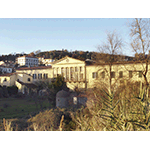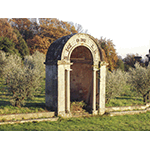Villa Puccini
Known with the name of "villone", the villa was built for Tommaso Puccini in the first half of the 18th century with the earnings from his profession as physician, and was modified in the course of time until it assumed its present neoclassical look.
In the 19th century, Niccolò Puccini, a promoter of the Parentalia Society to Great Italians, placed at the disposal of Filippo Pacini a microscope that the Pistoian scientist used in the villa to conduct his first anatomical and histological studies.
The spacious garden, realised between 1821 and 1844 by order of Niccolò Puccini, was furnished with various buildings, several of which were dedicated to science: a Pantheon to illustrious men, a Temple of Pythagoras, a monument to science, one to industry, a hemicycle dedicated to Galileo Galilei and a column surmounted by a statue of Carl Linnaeus, to whose memory the park was dedicated. The disposition of the hydraulic structure of the two lakes and of the brooks was entrusted to Pistoian architect Giovanni Gambini who, in that period, was also working on Villa Celle.
Emanuele Repetti defined the garden as a place «enchanted that would be difficult to describe as it deserves». Today, it no longer presents its original aspect, and several of its monuments have disappeared. Substantially unchanged, however, is the Gothic Castle (or Fortress), one of the monumental buildings that enriched the garden and that in 1836 became the habitual residence of Niccolò Puccini. Precise nineteenth-century descriptions, drafted on the occasion of the sale by auction of the property, testify that the middle tower had a lighting conductor on top of the roof, and curious contraptions which, according to a widespread anecdote, permitted Niccolò Puccini not to abandon his bedroom to receive guests: «the inner wall of this bedroom houses various brass handles that, by means of a proper mechanism, serve to open and close the window, open and close the entry gate and other uses, today out of order».
The property was divided first due to the construction of the road for Porretta, the new Via Leopolda (1847), and then by the construction of the Porrettana Railway (1864). The area that embraces the Fortress, the Gothic temple, the pantheon and several monuments, including the one to Galileo, were purchased in 1867 by Florentine attorney Oreste Ciampi. The remaining part of the complex is today a public park.
****************************
Texts by Graziano Magrini
English translation by Victor Beard
Last update 24/gen/2008





